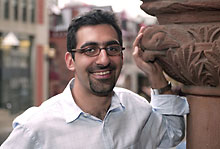Bazaar provides insight to understanding Iran

Arang Keshavarzian, Concordia’s new Middle East expert, says that his students are passionate about the region’s issues. The political science professor’s studies of the bazaar help us understand Iranian society.
Photo by Andrew Dobrowolskyj
Arang Keshavarzian is excited about being the new Middle East expert in Concordia’s Political Science Department. The young professor, who has just moved to Montreal from New York, has been impressed with his new students.
“They’re quite engaged with the issues facing the Middle East, and they’re quite passionate towards it,” said Iranian-born Keshavarzian, who grew up in the United States and recently completed his PhD at Princeton University.
Keshavarzian’s first impressions of Concordia, with its large community of Middle Eastern students, have been “very positive,” he said. His tenure-track position in the vibrant Political Science Department is his first as a full-time teacher.
“There’s a natural interest in the region, and an attachment,” he observed. “Not only are many of my students interested, but they have family members living in [the Middle East], they visit on a regular basis, and they speak and read the local languages.”
Keshavarzian, who teaches an introductory course on Middle Eastern politics, has had no trouble getting his students interested; if anything, his goal is to “make them step back a little bit from their immediate understanding of the region,” he said.
“I try to get them to think a little bit more broadly and analytically about the issues, [and] to reflect on what are some of the underlying factors driving the politics and societies of the region.”
In his dissertation, which he defended at Princeton just two months ago, Keshavarzian has written about politics in his native Iran. Specifically, he has researched the political organization of the bazaar, or central market, in the capital Tehran.
Comparing the bazaar’s potential for political mobilization before and after the Islamic revolution of 1979, Keshavarzian found that it has lost much of its potency as a force in Iranian society in the last couple of decades.
The Tehran bazaar, generally seen as a socially conservative bastion that has been supportive of the revolution, has become increasingly fragmented in recent years, he explained. This has been due largely to specific policies of the Islamic republic in such areas as urbanization, trade, and foreign exchange.
“If you would want to stereotype the bazari, he is considered someone who is extremely religious and socially conservative,” Keshavarzian said. What is often overlooked, however, is that there is also an economically liberal streak to the bazaar that, if recognized, would be quite compatible with the goals of reformists in Iran.
“What I find unfortunate is that many members of the reformist camp in Iran assume that the bazaar is supportive of the political status quo. They don’t work with some of these bazaris who would support their aspirations.”
Keshavarzian knows first-hand. He spent more than a year in Iran in 2000-2001, during which time he did many in-depth interviews with bazaris and observed their interactions. His aim was to fill a gap in the knowledge about the role of the bazaar in Iranian society.
“Many observers have talked about the important role played by the bazaar in social movements in Iran,” he said. “But while there is a general agreement on that issue, we have almost no field research on the bazaar.”
Keshavarzian’s research period coincided with the re-election of Iran’s president Khatemi, “a politically significant moment in Iran’s modern history.”
He found the people of Tehran very open to discussing politics. “Iran is an extremely politicized society, in part because of the revolution,” he said. “Whether it’s in taxicabs, in shops or in people’s homes, people are non-stop talking about politics.”